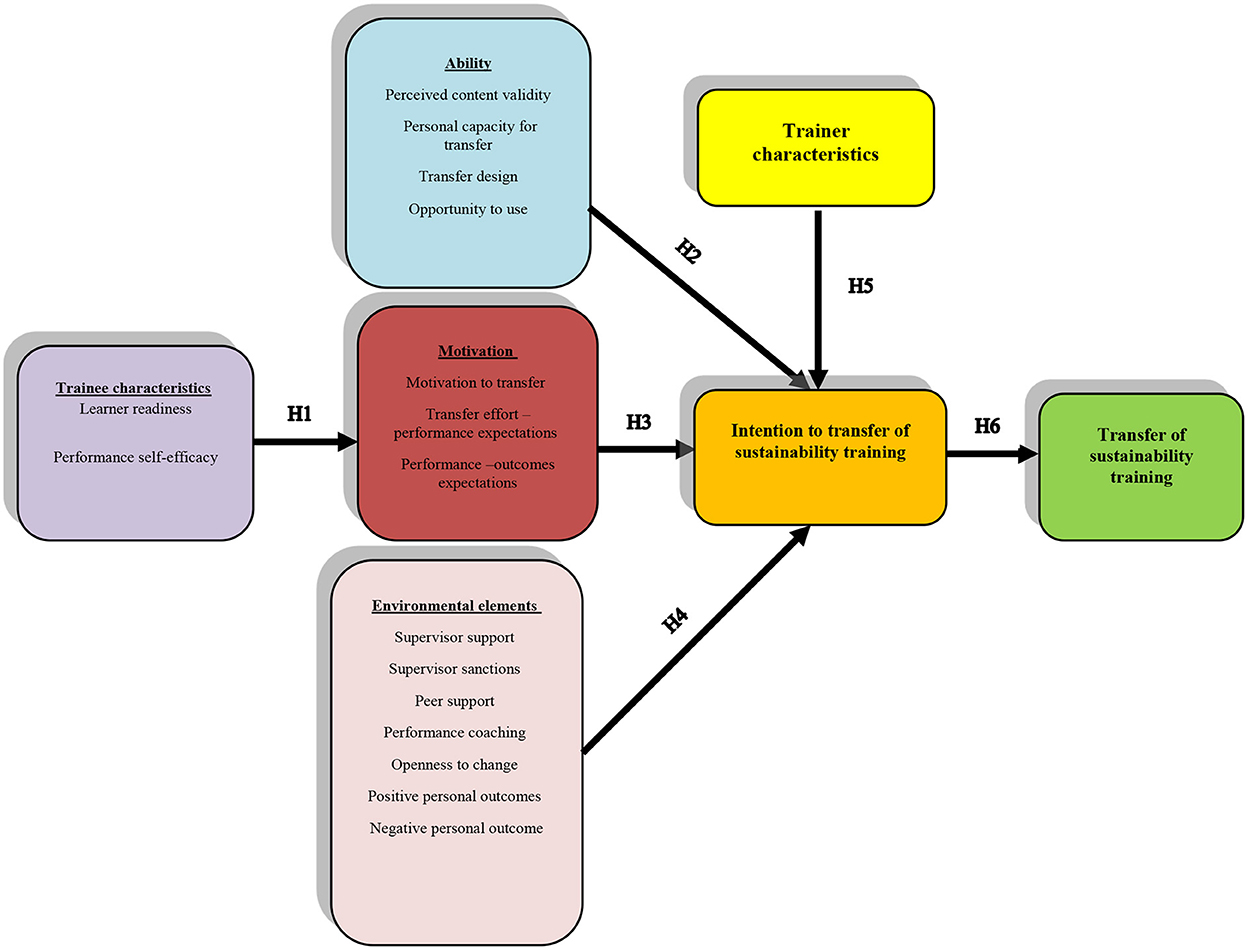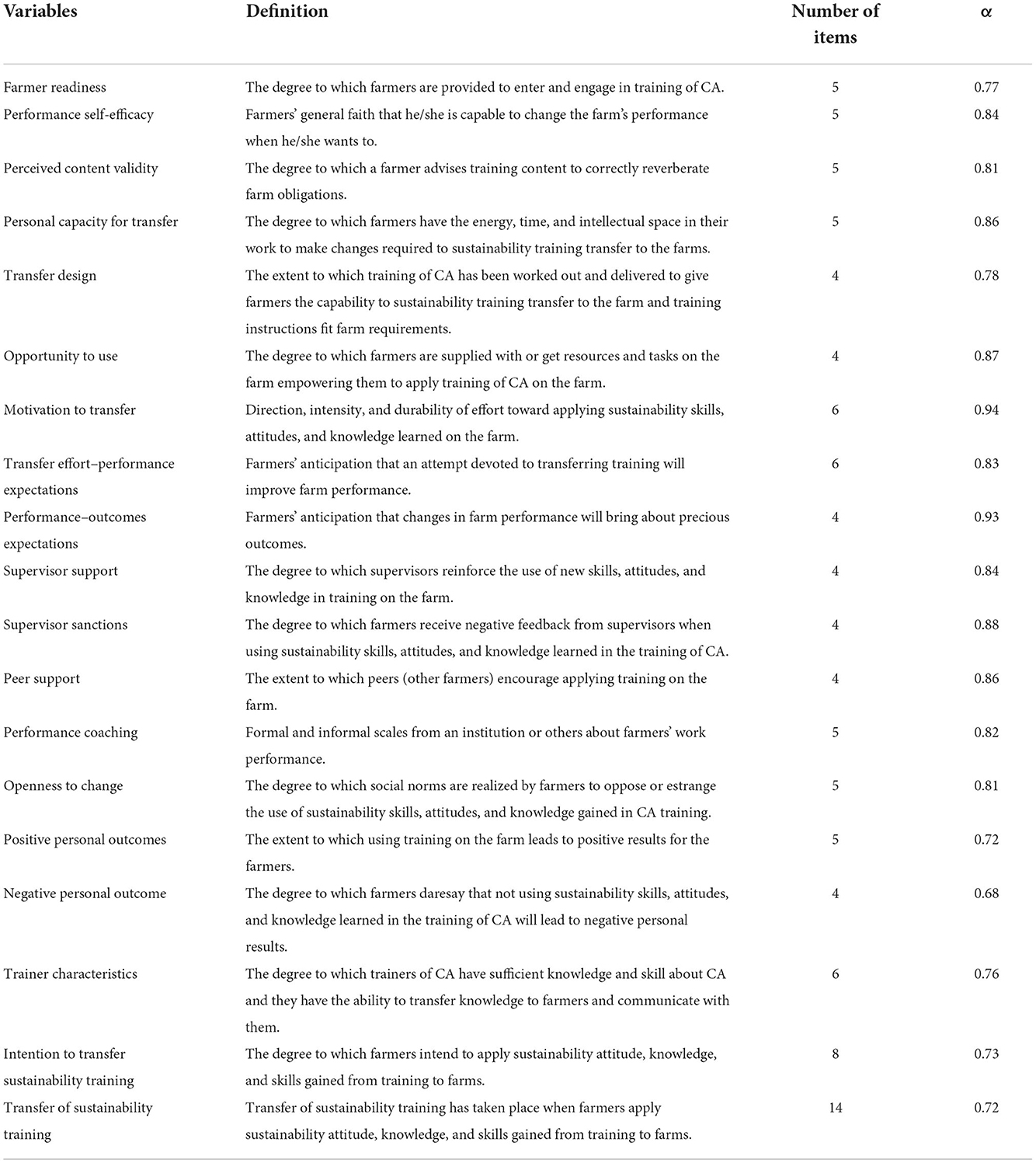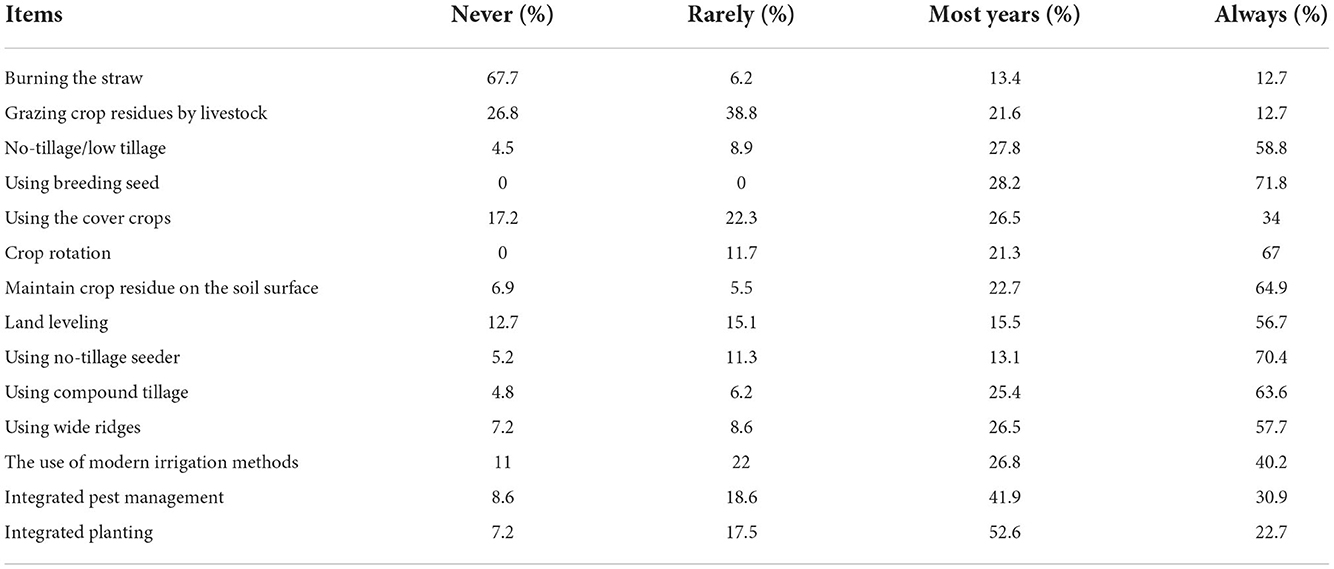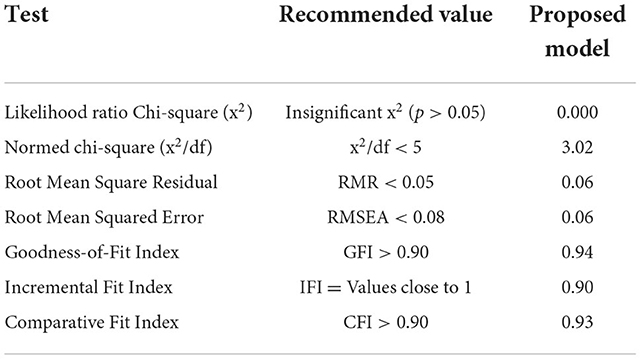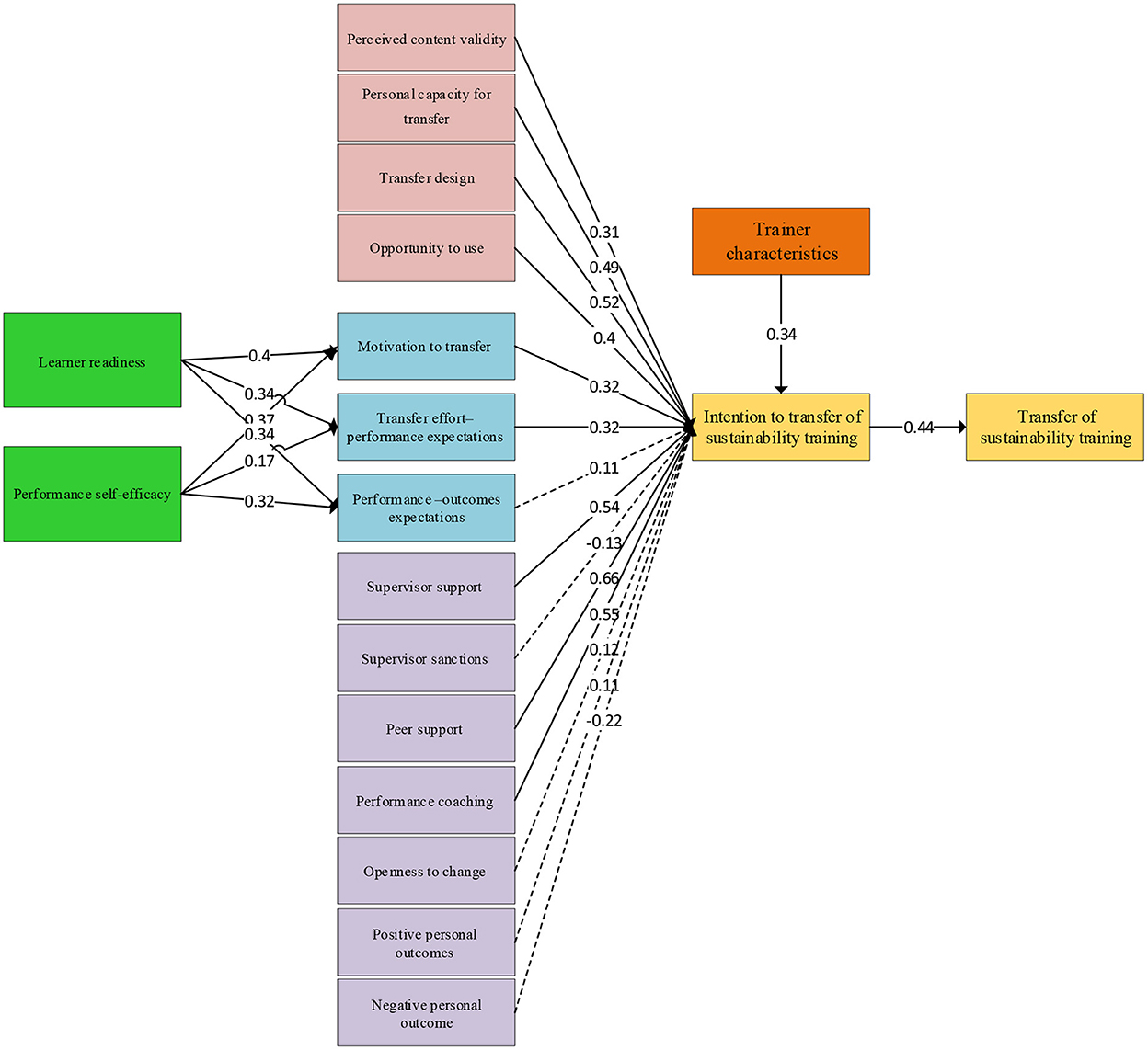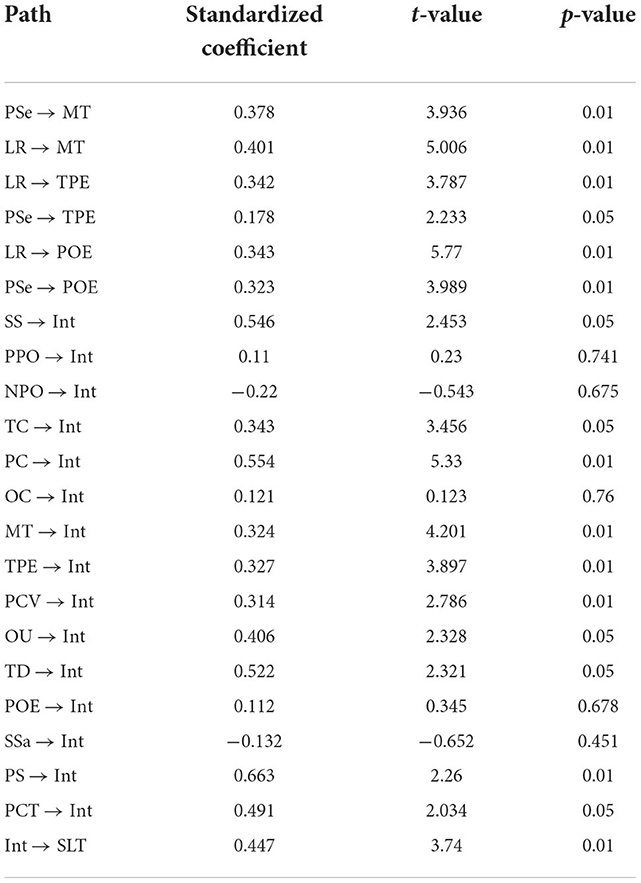- Department of Agricultural Extension and Education, Faculty of Agriculture, Tarbiat Modares University (TMU), Tehran, Iran
Introduction: The transfer of sustainability training means applying the skills, attitudes, and knowledge acquired from training to the workplace to help sustainability and environmental protection. This study aimed to conduct a behavioral analysis of sustainability training transfer among farmers that had attended extension-training courses on the Land and Conservation Agriculture Project (LCAP) in Iran.
Methods: This research is quantitative and applied research that was carried out via a standardized survey. The research population was composed of all farmers who attended LCAP extension training courses in the three provinces of Golestan, Fars, and Khouzestanin, Iran (N=1204). 291 farmers were selected through stratified random sampling. A panel of experts established the content and face validity of the questionnaire. A pilot study was conducted to check the reliability by calculating Cronbach's alpha.
Results and discussion: Findings indicated that most farmers had sustainability training transfer at a high level. The analysis with a structural equation model revealed that perceived content validity, transfer design, opportunity to use, supervisor support, trainer characteristics, peer support, motivation to transfer, transfer effort -performance expectations, performance coaching, and personal capacity for transfer influenced farmers' intention to transfer sustainability training significantly and positively. Furthermore, farmers' intentions had a significant effect on their transfer of sustainability training. It can be concluded that a sustainability training transfer system is applicable to a training context related to sustainable agriculture and can provide a useful instrument for agricultural education organizations when investing in farmers' training.
Introduction
Economic growth, population dynamic, and industrial development have made fundamental changes in the natural environment during the past 50 years. Agricultural systems are responsive to the emergence of many environmental problems in many developing countries such as Iran. This is despite the fact that agricultural activities overuse chemical fertilizers, pesticides, and other chemical inputs. These activities have caused the degradation of natural resources and have had negative impacts on human health, ecosystems, and biodiversity (Settle and Garba, 2011; Yang et al., 2015; Ataei et al., 2019). Governments use different methods to change farmers' behavior toward sustainability. In general, these methods can be classified into three categories: laws and regulations, voluntary behaviors, and financial incentives. Incentives, as well as laws and regulations, will have short-term impacts. But, voluntary methods entail long-term and positive impacts on sustainable agriculture. It is, however, necessary to understand farmers' willingness and ability to take sustainability activities (Mills et al., 2017). Therefore, it is crucial to collect information on how people learn and apply sustainability principles (Singh et al., 2013; Ataei et al., 2021).
Sustainable agriculture relies on farmers' knowledge, attitude, skill, and management (Ahnstrom et al., 2009; Abu Samah et al., 2012; Sadeghi et al., 2020). Lambrechts et al. (2013) argue that to apply sustainability principles and tackle sustainability challenges, one needs sustainability knowledge, skills, values, and attitudes. Therefore, farmers' knowledge, skills, needs, and perceptions should provide an integrated part of the process of sustainable agricultural development (Onduru and Du Preez, 2008). With this integration, sustainability training will also be transferred among farmers. The transfer of sustainability training means applying the skills, attitudes, and knowledge acquired from training to the workplace to help sustainability and environmental protection. Therefore, sustainability training is said to be transferred when farmers apply sustainability knowledge, attitude, and skills learned from training programs to the farms. Considering the importance of sustainable agriculture and the essential role of farmers in achieving this goal, the study aimed to conduct a behavioral analysis of sustainability training transfer among farmers participating in extension training courses on the land and conservation agriculture project.
A lot of studies have been carried out on training transfer. However, the applications of the training transfer system (TTS) to signal training transfer are still limited. Even those who have tried to apply the system have gained some results. Applying TTS to recognize the components that can predict training transfer indicates that even the dependent variables applied so far have differed. Nonetheless, some dependent variables have been applied in the procedure. Hutchins et al. (2013) utilized the intention to transfer as the dependent variable in their theoretical framework of the research, while Bates et al. (2007), Devos et al. (2007), Velada et al. (2009), and Miiro et al. (2012) addressed real transfer following training. Bates and Khasawneh (2005) measured training transfer in the field of perceived organization innovativeness.
Minja et al. (2022) advanced andragogy by showing the contextual nature of the applicability of its principles, as well as the dependence of training transfer on contextual factors surrounding trainees. Santana-Domínguez et al. (2022) proposed the training transfer system as the basis for future empirical studies to maximize the utility of training programs for various fields. Twase et al. (2022) explained motivation and perceived content validity to strongly influence training transfer. Perceived content validity mediated the relationship between motivations to implement acquired knowledge and training transfer. Gemmano et al. (2022) found that training transfer was positively related to each dimension of work performance: proficiency, adaptivity, and proactivity. Kuo and Tien (2022) illustrated that motivation to learn and transfer design positively influenced motivation to transfer, while it positively impacted overall individual performance. Dixit and Sinha (2022) showed that the effectiveness and efficiency of training transfer tools were strongly correlated and enabled the workplace application of skills and knowledge. Creon and Schermuly (2022) revealed that the training individuals' psychological empowerment mediated the positive relationship between transformational trainer behavior and training transfer. Kalule et al. (2019) stated that perceived value of content mediated extension agents' supervision support in predicting farmers' intention to apply what they had learned during extension training programs.
According to these studies, it is clear that there is a reasonable and logical relationship between the transfer of sustainability training and farmers' behavior, which needs the integration of behavioral issues with the training transfer system. In this way, farmers will gain sustainability knowledge, attitude, and skills through teamwork with extension agents and researchers and apply them to their farms. Farmers have presented a type of behavior, generally referred to as the transfer of sustainability training by applying knowledge and skills that they have learned during training. However, several factors and variables can affect the transfer of sustainability training. On the other hand, it can be inferred that the training transfer system follows, to a large extent, the components of the educational system. There are four pillars in the educational system, including educational content, trainee, trainer, and educational environment. With a glance at the training transfer system, it can be assumed that the variables of trainee characteristics and motivational factors are regarded as the trainee element, the variables of ability are related to the educational content, and the environmental elements of the training transfer system are regarded as the educational environment (Newcomb et al., 2004; Fallah Haghighi et al., 2018, 2020). But, the status of the trainer element is absent in this system whereas trainers have an important role to play in a learning and training system that aims to empower trainees to apply training on the job. Therefore, trainee characteristics can be incorporated into the theoretical framework of TTS to supplement the framework in terms of the components of the training system. Accordingly, the conceptual framework of the research was designed as depicted in Figure 1. Successful training transfer is necessary for farmers to adapt to a fast-changing climate. Organizations of Agriculture expect farmer training and development to lead to a return on investment. Thus, they want farmers to improve their productivity by using the skills and knowledge that they learn during extension training courses. However, this return on investment can be reduced by the lack of training transfer (i.e., the on-the-farm application of knowledge and skills acquired in an extension training program). This study contributes to the literature in several ways. First, it is one of the recent studies to investigate the transfer of sustainability training in the land and conservation agriculture project. Second, the study extends the training transfer literature by estimating how the land and conservation agriculture project can generate knowledge and skills spillovers associated with sustainable agriculture. Third, the results add to the discourse on the importance of trainer characteristics for farmers' training transfer and offer a new perspective on training as changing the farmers' self-concept. Finally, the study focuses on implications for the transfer of sustainability training and thus contributes to the growing literature on extension training programs. Given the theoretical framework of the study, the following hypotheses are considered to accomplish the research goals:
• Hypothesis 1: trainee characteristics influence components of motivation positively and significantly.
• Hypothesis 2: ability factors influence farmers' intention to transfer sustainability training positively and significantly.
• Hypothesis 3: motivational factors influence farmers' intention to transfer sustainability training positively and significantly.
• Hypothesis 4: environmental elements influence farmers' intention to transfer sustainability training positively and significantly.
• Hypothesis 5: trainer characteristics influence farmers' intention to transfer sustainability training positively and significantly.
• Hypothesis 6: farmers' intention influences their transfer of sustainability training positively and significantly.
Methods
The present research was a quantitative study, which used a survey to accomplish its objectives. It was also a causal-relational study in terms of data analysis. Data were collected with a questionnaire whose face and content validity was confirmed by a panel of experts and its reliability was established by calculating Cronbach's alpha in a pilot study, which was estimated at a range of 0.68–0.94. A five-point Likert scale (from very low = 1 to very high = 5) was utilized to estimate the variables. Definitions and reliabilities of the variables and sample items are presented in Table 1.
The research focused on conservation agriculture (CA) training courses in three Iranian provinces of Fars, Khouzestan, and Golestan. These provinces have the highest CA cultivation area. Fourteen CA principles and indicators were employed to measure the transfer of sustainability training. They were presented to the farmers in CA training courses. These indicators included burning the straw, grazing crop residues by livestock, no/low tillage, using improved seeds, cultivating cover crops, crop rotation, maintaining crop residues on the soil surface, land leveling, applying no-tillage seeders and compound tillage, using wide ridges, integrated pest management, using modern irrigation methods, and integrated planting. All farmers who attended CA extension training courses in these provinces constituted the research population (N = 1,204). In Iran, CA was first begun to practice in four provinces of Khuzestan, Fars, Golestan, and Khorasan on an area of 150 hectares in 2007. It was, then, disseminated to the other provinces. A comprehensive organization was founded with the formation of the Supreme CA Headquarters in the Ministry of Agriculture and Technical Committee at the ministerial level, provincial agricultural organization, and management of the townships in 2014. In a land and conservation agriculture project, a team of researchers, farmers, and extension agents cooperated to train farmers on how to apply the CA principles in their farms. The degree to which farmers apply the CA principles learned in the training course at their farms is considered the transfer of sustainability training. A sample was taken by stratified random sampling from farmers who attended CA extension training courses. The provinces/counties were used as strata. Stratified random sampling is used when a population is divided into several strata based on the variance of a feature (here, CA cultivation area). In this case, the variance of the target feature is within the low strata and between the high strata. The strata in this research included the counties where the CA project was undergoing (The criterion to choose the counties was the highest CA cultivation area in the province). After the strata were formed, the samples were taken from them randomly. The sample size was 291 according to Krejcie and Morgan's (1970) table: 94 farmers from Fars province, 82 from Khouzestan province, and 115 from Golestan province. The SPSS23 and AMOS23 software suites were used for data analysis. Structural equation modeling (SEM) was also utilized for analyzing the structural relationship between the measured and the latent constructs.
Findings
Extent of sustainability training transfer
Fourteen indicators were used to measure the transfer of sustainability training among farmers who attended CA extension training courses. These indicators were trained for farmers during different periods. The findings showed that 67.7% of the farmers never burnt crop residues and 38.8% rarely had their crop residues grazed. Also, 58.8%, 71.8%, 34%, 67%, and 56.7% always used no/low tillage, improved seeds, cover crops, crop rotation, and land leveling, respectively.
Another main principle of CA is to keep crop residue on the soil surface. Farmers participating in extension training programs should apply it to their farms. The findings showed that 64.9% of the farmers always maintained crop residues on the soil surface. Using CA machinery is another issue that was trained to farmers. In this regard, 70.4% and 63.6% of the farmers always used no-tillage seeders and compound tillage, respectively. Also, 57.7% and 40.2% always used wide ridges and modern irrigation methods, respectively. Finally, 52.6% and 41.9% of the farmers mostly used integrated planting and integrated pest management, respectively. Other findings are presented in Table 2.
In general, the ISDM criteria (Davis, 1971) were used to extend the status of farmers' sustainability training transfer (Formula 1). Based on the results, 24.40% of the farmers had a weak sustainability training transfer. In other words, 24.40% of the farmers used the skills, knowledge, and attitude of sustainability that they had learned in the CA extension training courses at a low level. Also, 33.68% and 41.92% had moderate and high sustainability training transfers, respectively. Accordingly, the majority of farmers had a high sustainability training transfer. This means that most of them used the skills and knowledge they gained at the training courses at a high level.
Measurement model estimation
The validity, reliability, and fit of the model were measured by estimating the measurement model through confirmatory factor analysis. Based on the results, after deleting two observed variables, most of the standardized loadings of other observed variables were significant. In addition, AVE and CR estimated for all latent variables were larger than 0.5 and 0.7, respectively (Table 3). According to Hair et al. (2010), AVE and CR values for each latent variable should be larger than 0.5 and 0.7, respectively. Thus, convergent validity and composite reliability of the questionnaire were evident.
Structural model estimation
The goodness of fit indicates the extent to which the model fits the data and the paths in the analysis. AMOS was used to estimate the model fit indicators including relative chi-square or normal chi-square (CMIN/DF), root mean square error of approximation (RMSEA), root mean square residual (RMR), the goodness of fit index (GFI), incremental fit index (IFI), and comparative fit index (CFI). The model generally exhibited adequate GFI (Table 4). Its ratio of chi-square to degrees of freedom was 3.35, reflecting a good fit of the model (less than 5; Byrne, 2016). The value of RMSEA was estimated at 0.076, which meets the requirement of <0.08 (Byrne, 2016). The values of GFI and CFI were >0.9, indicating a good model fit (Byrne, 2016).
According to the structural model, trainee characteristics had a direct effect on motivational factors and an indirect effect on the intention to transfer sustainability training. As a structural model (Figure 2), it could be noticed that “learner readiness” influenced “motivation to transfer” positively and significantly (β = 0.33, P < 0.01). Another path was from learner readiness to “transfer effort–performance expectations” and “performance–outcomes expectations”, which had a positive and significant influence on them (β = 0.25, P < 0.01; β = 0.36, P < 0.01, respectively).
The model recommends that “performance self-efficacy” had a positive and significant effect on the three latent variables of “performance–outcomes expectations,” “motivation to transfer,” and “transfer effort–performance expectations” (β = 0.30, P < 0.01, β = 0.32, P < 0.01; β = 0.15, P < 0.05, respectively). This supports hypothesis 1 regarding the positive and significant effect of trainee characteristics on the components of motivation. According to Holton et al. (2000), Holton (2005), Bates et al. (2012), Ataei and Zamani (2015), and Muthoni and Miiro (2017), trainee attributes (learner readiness and performance self-efficacy) are influential components in the training transfer system. They especially argue that trainee characteristics have a significant effect on motivational factors.
According to the structural model, motivational factors, ability factors, trainer characteristics, and environmental elements had a direct effect on the intention to transfer sustainability training and an indirect effect on the transfer of sustainability training. Among ability factors, perceived content validity (β = 0.30, P < 0.01), transfer design (β = 0.53, P < 0.05), personal capacity for transfer (β = 0.45, P < 0.05), and opportunity to use (β = 0.47, P < 0.05) had direct, significant, and positive effects on intention to transfer sustainability training. This supports hypothesis 2 (ability factors influence farmers' intention to transfer sustainability training positively and significantly).
Motivational factors were included in three variables. According to findings, “motivation to transfer” and “transfer effort-performance expectations” had a direct, significant, and positive effect on farmers' intention to transfer sustainability training (β = 0.19, P < 0.01 and β = 0.18, P < 0.01, respectively). However, the effect of performance-outcomes expectations on farmers' intention to transfer sustainability training was not significant, which refutes hypothesis 3. These findings imply that farmers with higher performance-outcome expectations about CA have more intention to apply sustainability skills, knowledge, and attitude to the farm. The results agreed with the results of numerous empirical studies such as Bates et al. (2007), Devos et al. (2007), Velada et al. (2009), Daffron and North (2011), Miiro et al. (2012), Ataei and Zamani Miandashti (2014a), and Zamani et al. (2016). But, performance–outcome expectations did not have a significant effect on farmers' intentions.
As shown in Figure 2, the effect of performance coaching, supervisor, and peer support (β = 0.39, P < 0.05; β = 0.5, P < 0.05; β = 0.66, P < 0.01, respectively) was direct, significant, and positive on farmers' intention. However, openness to change, supervisor sanctions, positive personal outcomes, and negative personal outcomes had no significant effect on the farmers' intention to transfer sustainability training. This refutes hypothesis 4, i.e., ability factors affect the intention to transfer sustainability training positively and significantly. Thus, the comprehensive support of supervisors and other farmers will expand farmers' intention to transfer sustainability training. Also, formal and informal indicators from the Organization of Agriculture Jahad or others about farmers' work performance can promote their intention to apply sustainability skills, knowledge, and attitude at their farms. The findings are consistent with the results of Ingram et al. (2009), Oreszczyn et al. (2010), Quinn and Burbach (2010), Ataei and Zamani Miandashti (2014b), and Lee et al. (2014) who suggest that performance coaching, supervisor, and peer support increase farmers' intentions.
Also, trainer characteristics, with a path coefficient of 0.20 (P < 0.05), had a direct and significant effect on farmers' intention to transfer sustainability training. So, hypothesis 5 (trainer characteristics influence farmers' intention to transfer sustainability training positively and significantly) is confirmed. Finally, farmers' intention influenced the transfer of sustainability training directly and significantly (β = 0.45, P < 0.01), confirming hypothesis 6 (farmers' intention influences their transfer of sustainability training positively and significantly). This finding was supported by several studies (Daffron and North, 2011; Hutchins et al., 2013; Pineda-Herrero et al., 2014; Turab and Casimir, 2015). So, intention can play the main role in the transfer of sustainability training. Other findings are provided in Table 5.
Conclusion
In the context of agricultural organizations, a positive transfer of sustainability training by farmers is generally regarded as the premier goal of training efforts, which is yet a massive challenge. Thus, this research was conducted to determine the components of TTS that influence the training transfer of sustainability skills, attitudes, and knowledge to the farms among farmers who had attended the CA extension training courses. This research contributes to training transfer studies by combining sustainability issues with the learning transfer system inventory. Also, levels of sustainability training transfer were evaluated among farmers. Based on the level of transfer of sustainability training, most farmers applied the sustainability skills and knowledge gained from CA training at a high level. It is concluded that the training programs of CA were an efficient and valuable plan. Therefore, the efficient training programs of CA will facilitate and accelerate the development of CA.
Based on the analysis of the structural equation model, most variables influenced farmers' intention to apply sustainability skills on the farm significantly. For example, supervisor support was found to be one of the main factors for the successful transfer of sustainability training back to the farm. Therefore, comprehensive support by supervisors and other farmers (peers) will maximize sustainability training transfer. Extension agents and researchers should facilitate training and support of farmers not only during CA training but also before and after the courses. Personal capacity was a main predictive variable to effectively transfer the skills gained during training to the workplace (farms). In other words, the extent of sustainability training transfer will improve if farmers have the time, energy, and mental space in their workplace. Also, performance coaching was recognized to be necessary for the process of training transfer. Formal and informal scales from an organization about farmers' work performance can affect farmers' sustainability training transfer.
The results illustrate that motivational factors play an important role in sustainability training transfer among farmers. Scholars have suggested motivational factors as the mediating function between components in the training transfer system and training transfer. One factor that had a significant impact on farmers' intention was the transfer design. If CA instructions are relevant and similar to the ones given on the farmers' work, the transfer will occur more easily. One of the influential factors in the farmers' intention was the trainers' characteristics. Trainers should have diverse characteristics to facilitate the transfer of CA knowledge, attitude, and skills to farmers. Therefore, farmers' intention to transfer sustainability training will increase if trainers have sufficient knowledge and skill about CA, environmental attitude, and the ability to communicate with farmers and transfer knowledge to them. Also, the opportunity to use, personal capacity for transfer, and performance coaching, as well as giving off positive response, emerged as additional main components associated with improving farmers' intention. Accordingly, it is crucial to ensure that farmers have the time and personal capacity to apply new skills and are keen to attend training courses through more objective negotiations with the farmers and the Organization of Agriculture Jahad or private training institutes, and supervisors before, during, and after the training program.
Farmers' intention to apply the principles of CA was an effective factor in the sustainability training transfer. This means that if the transfer behavior is novel, farmers will probably produce beliefs on the transfer behavior by the time they return to the farm and try to transfer their learned knowledge, attitudes, and skills related to CA. This implies that by the end of the CA training course, farmers will usually have decided on the degree to which they will use their learned skills to farms. This intention is then reinforced by their dispositional attributes and tendency about the training content of CA, performance outcomes, and expected outputs, and the comprehensive support the farmers will obtain when coming back to the farm, thus tapping components that are captured in the main measures of the sustainability training transfer system.
According to the findings, it is recommended to consider all dimensions of the extent of sustainability training transfer by farmers. First, authorities of the CA project should conduct the CA training system (training content and transfer design) based on the agricultural sector and farmers' problems. Then, farmers' abilities (subjective, technical, and knowledge readiness) to apply the principles of CA should be investigated. Also, the organizational environment should be aligned with reinforcing and supporting farmers and CA development. Finally, it can be concluded that the sustainability training transfer system is applicable to a training context related to the sustainable agriculture sector and thus can be a useful instrument for agriculture organizations when investing in farmers' training. Also, the research further opens up the sustainable agriculture sector as the main context of the sustainability training transfer system and relevant research. Furthermore, this study opens the case for combining social-psychological theories with the components of training transfer as mediation variables within training transfer studies.
One of the most important limitations of this study was the extent to which farmers' intentions to use acquired knowledge and skill became training transfer. It is not possible to argue exactly that all farmers who have a strong intention implement new knowledge and skill on the farm.
Data availability statement
The raw data supporting the conclusions of this article will be made available by the authors, without undue reservation.
Ethics statement
Written informed consent from the participants was not required to participate in this study in accordance with the national legislation and the institutional requirements.
Author contributions
Conceptualization: PA, HS, and EA. Methodology and writing: PA and EA. Software: PA. Validation: PA, HS, MC, and EA. All authors contributed to the article and approved the submitted version.
Conflict of interest
The authors declare that the research was conducted in the absence of any commercial or financial relationships that could be construed as a potential conflict of interest.
Publisher's note
All claims expressed in this article are solely those of the authors and do not necessarily represent those of their affiliated organizations, or those of the publisher, the editors and the reviewers. Any product that may be evaluated in this article, or claim that may be made by its manufacturer, is not guaranteed or endorsed by the publisher.
References
Abu Samah, B., D'silva, J. L., Mohamed shaffril, H. A., Man, N., and Azman, A. (2012). Malaysian contract farmers' attitude towards sustainable agriculture. J. Basic Appl. Sci. Res. 2, 9205–9210.
Ahnstrom, J., Hockert, J., Bergea, H. L., Francis, C. A., Skelton, P., Hallgren, L., et al. (2009). Farmers and nature conservation: what is known about attitudes, context factors and actions affecting conservation? Renew. Agric. Food Systems 24, 38–47. doi: 10.1017/S1742170508002391
Ataei, P., Sadighi, H., Aenis, T., Chizari, M., and Abbasi, E. (2021). Challenges of applying conservation agriculture in Iran: an overview on experts and farmers perspectives. Air Soil Water Res. 14, 1–12. doi: 10.1177/1178622120980022
Ataei, P., Sadighi, H., Chizari, M., and Abbasi, E. (2019). Analysis of farmers' social interactions to apply principles of conservation agriculture in Iran (Application of Social Network Analysis). J. Agric. Sci. Technol. 21, 1657–1671.
Ataei, P., and Zamani Miandashti, N. (2014a). Motivation of participating farmers and stockmen in fars research finding diffusion-push projects to implement suggested technologies. Agric. Educ. Admin. Res. 29, 96–107.
Ataei, P., and Zamani Miandashti, N. (2014b). Investigation of factors influencing the implementation of the recommendations of Research Finding Diffusion-Push Plans by farmers' Fars province. J. Agric. Econ. Dev. Research 45, 93–106.
Ataei, P., and Zamani, N. (2015). Determinants of the transfer of sustainability learning in agriculture sector of Iran. J. Agric. Sci. Technol. 17, 1437–1447.
Bates, R., Holton, E. F., and Hatala, J. P. (2012). A revised learning transfer system inventory: factorial replication and validation. Hum. Resour. Dev. Int. 15, 549–569. doi: 10.1080/13678868.2012.726872
Bates, R., Kauffeld, S., and Holton, E. F. I. I. I. (2007). Examining the factor structure and predictive ability of the German?version of the Learning Transfer Systems Inventory (LTSI). J. Eur. Industr. Train. 3, 195–211. doi: 10.1108/03090590710739278
Bates, R., and Khasawneh, S. (2005). Organizational learning culture, learning transfer climate and perceived innovation in Jordanian organizations. Int. J. Train. Dev. 9, 96–109. doi: 10.1111/j.1468-2419.2005.00224.x
Byrne, B. (2016). Structural Equation Modeling with AMOS: Basic Concepts, Applications, and Programming, 3rd Edn. Routledge, New York: Taylor and Francis Group. doi: 10.4324/9781315757421
Creon, L. E., and Schermuly, C. C. (2022). A new path to training transfer: Transformational trainers and psychologically empowered training participants. Int. J. Train. Dev. 26, 228–244. doi: 10.1111/ijtd.12256
Daffron, S. R., and North, M. W. (2011). Successful Transfer of Learning. Melbourne: Krieger Publishing Company.
Devos, C., Dumay, X., Bonami, C., Bates, R., and Holton, E. F. I. I. I. (2007). The learning transfer system inventory (LTSI) translated into French: internal structure and predictive validity. Int. J. Train. Dev. 11, 181–199. doi: 10.1111/j.1468-2419.2007.00280.x
Dixit, R., and Sinha, V. (2022). Investigating tools and techniques to promote workplace training transfer. J. Workplace Learn. 34, 513–531. doi: 10.1108/JWL-04-2021-0052
Fallah Haghighi, N., Bijani, M., and Parhizkar, M. (2020). Social pathology of brain drain in Yazd Province, Iran: a grounded theory approach. GeoJournal 85, 93–106. doi: 10.1007/s10708-018-9959-z
Fallah Haghighi, N., Hajihoseini, H., Ramezanpour Nargesi, G., and Bijani, M. (2018). Gap analysis of current and desired states of entrepreneurship development components in the field of ICTs in Iran. Technol. Soc. 54, 101–110. doi: 10.1016/j.techsoc.2018.03.003
Gemmano, C. G., Manuti, A., and Giancaspro, M. L. (2022). It's just a matter of culture: an explorative study on the relationship between training transfer and work performance. J. Workplace Learn. 34, 532–548. doi: 10.1108/JWL-10-2021-0133
Hair, J., Black, C., Babin, J., and Anderson, E. (2010). Multivariate Data Analysis. USA: Prentice Hall Publisher.
Holton, E. F. I. I. I. (2005). Holton's evaluation model: new evidence and construct elaborations. Adv. Dev. Hum. Resour. 7, 37–54. doi: 10.1177/1523422304272080
Holton, E. F. I. I. I., Bates, R. A., and Ruona, W. E. (2000). Development of a generalized learning transfer system inventory. Hum. Resour. Dev. Q. 11, 333–360.
Hutchins, H. M., Nimon, K., Bates, R., and Holton, E. (2013). Can the LTSI predict transfer performance? Testing intent to transfer as a proximal transfer of training outcome. Int. J. Select. Assess. 21, 251–263. doi: 10.1111/ijsa.12035
Ingram, J., Short, C., Gaskell, P., Mills, J., Lewis, N., Clark, M., et al. (2009). Entry and Exit From Agri-Environmental Schemes in Wales. Final report for Welsh Assembly Government. Cheltenham: Countryside and Community Research Institute.
Kalule, S. W., Sseguya, H., Ongeng, D., and Karubanga, G. (2019). Facilitating conditions for farmer learning behaviour in the student-to-farmer university outreach. J. Agric. Educ. Ext. 25, 211–225. doi: 10.1080/1389224X.2019.1604389
Krejcie, R. V., and Morgan, D. W. (1970). Determining sample size for research activities. Educ. Psychol. Measur. 30, 607–610. doi: 10.1177/001316447003000308
Kuo, T. H., and Tien, H. K. (2022). Mechanisms of learning transfer in creativity training. J. Workplace Learn. 34, 609–627. doi: 10.1108/JWL-08-2021-0107
Lambrechts, W., Mula, I., Ceulemans, K., Molderez, I., and Gaeremynck, V. (2013). The integration of competences for sustainable development in higher education: an analysis of bachelor programs in management. J. Clean. Prod. 48, 65–73. doi: 10.1016/j.jclepro.2011.12.034
Lee, C., Lee, H., Lee, J., and Park, J. (2014). A multiple group analysis of the training transfer model: exploring the differences between high and low performers in a Korean insurance company. Int. J. Hum. Resour. Manage. 25, 2837–2857. doi: 10.1080/09585192.2014.934887
Miiro, R. F., Mazur, R. E., and Matsiko, F. B. (2012). Factors in the transfer of governance-facilitation skills within farmers' marketing organizations in Uganda. J. Agric. Educ. Ext. 18, 231–245. doi: 10.1080/1389224X.2012.670051
Mills, J., Gaskell, P., Ingram, J., Dwyer, J., Reed, M., Short, C., et al. (2017). Engaging farmers in environmental management through a better understanding of behaviour. Agric. Hum. Values 34, 283–299. doi: 10.1007/s10460-016-9705-4
Minja, J. J., Mbura, O. K., and Charles, G. (2022). The influence of trainees' characteristics on the transfer of entrepreneurship training: evidence from microfinance institutions in Tanzania. Int. J. Train. Dev. 26, 448–471. doi: 10.1111/ijtd.12266
Muthoni, R. A., and Miiro, R. F. (2017). What influences transfer of training in an African agricultural research network? J. Agric. Educ. Ext. 23, 23–37. doi: 10.1080/1389224X.2016.1207550
Newcomb, L. H., McCracken, J. D., Warmbrod, J. R., and Whittington, M. S. (2004). Methods of Teaching Agriculture (Third). New Jersey: Pearson Prentice Hall.
Onduru, D. D., and Du Preez, C. C. C. (2008). Farmers' knowledge and perceptions in assessing tropical dryland agricultural sustainability: experiences from Mbeere District, Eastern Kenya. Int. J. Sustain. Dev. World Ecol. 15, 145–152. doi: 10.1080/13504500809469779
Oreszczyn, S., Lane, A., and Carr, S. (2010). The role of networks of practice and webs of influencers on farmers' engagement with and learning about agricultural innovations. J. Rural Stud. 26, 404–417. doi: 10.1016/j.jrurstud.2010.03.003
Pineda-Herrero, P., Quesada-Pallarès, C., and Ciraso-Calí, A. (2014). “Evaluation of training transfer factors: the FET model,” in Transfer of Learning in Organizations, ed. K. Schneider (Switzerland: Springer). p. 121–144. doi: 10.1007/978-3-319-02093-8_8
Quinn, C. E., and Burbach, M. E. (2010). A test of personal characteristics that influence farmers' pro-environmental behaviors. Great Plains Res. 20, 193–204.
Sadeghi, A., Bijani, M., and Farhadian, H. (2020). The mediating role of farmers' time perspective in water resources exploitation behaviour in the Eastern Area of Lake Urmia, Iran: an environmental-psychological analysis. Water Environ. J. 34 (Suppl. S1), 106–120. doi: 10.1111/wej.12510
Santana-Domínguez, I., Ballesteros-Rodríguez, J. L., and Domínguez-Falcón, C. (2022). An application of training transfer literature to the analysis of training for entrepreneurship: a conceptual model. Int. J. Manage. Educ. 20. doi: 10.1016/j.ijme.2022.100649
Settle, W., and Garba, M. H. (2011). Sustainable crop production intensification in the Senegal and Niger River basins of francophone West Africa. Int. J. Agric. Sustain. 9, 171–185. doi: 10.3763/ijas.2010.0559
Singh, R. K., Singh, A., and Pandey, C. B. (2013). Agro-biodiversity in rice-wheat-based agroecosystems of eastern Uttar Pradesh, India: implications for conservation and sustainable management. Int. J. Sustain. Dev. World Ecol. 21, 46–59. doi: 10.1080/13504509.2013.869272
Turab, G. M., and Casimir, G. (2015). A model of the antecedents of training transfer. Int. J. Train. Res. 13, 82–95. doi: 10.1080/14480220.2015.1051352
Twase, I., Miiro, R. F., Matsiko, F., Ndaula, S., and Ssamula, M. (2022). Mediation of perceived content validity on motivation and training transfer among smallholder farmers in Central Uganda. Int. J. Train. Dev. 26, 55–68. doi: 10.1111/ijtd.12236
Velada, R., Caetano, A., Bates, R., and Holton, E. F. I. I. I. (2009). Learning transfer – validation of the learning transfer system inventory in Portugal. J. Eur. Industr. Train. 33, 635–656. doi: 10.1108/03090590910985390
Yang, G. J., Utzinger, J., and Zhou, X. N. (2015). Interplay between environment, agriculture and infectious diseases of poverty: case studies in China. Acta Tropica 141, 399–406. doi: 10.1016/j.actatropica.2013.07.009
Keywords: transfer of sustainability training, land and conservation agriculture project, sustainable agriculture, training transfer system, farmers' behavior
Citation: Ataei P, Sadighi H, Abbasi E and Chizari M (2022) Transfer of sustainability training in land and conservation agriculture project: A behavioral study in Iran. Front. Sustain. Food Syst. 6:1051930. doi: 10.3389/fsufs.2022.1051930
Received: 23 September 2022; Accepted: 29 November 2022;
Published: 15 December 2022.
Edited by:
Moslem Savari, Khuzestan University of Agricultural Sciences and Natural Resources, IranReviewed by:
Rezaei Rohollah, University of Zanjan, IranRazieh Namdar, Shiraz University, Iran
Mehrdad Pouya, Bu-Ali Sina University, Iran
Copyright © 2022 Ataei, Sadighi, Abbasi and Chizari. This is an open-access article distributed under the terms of the Creative Commons Attribution License (CC BY). The use, distribution or reproduction in other forums is permitted, provided the original author(s) and the copyright owner(s) are credited and that the original publication in this journal is cited, in accordance with accepted academic practice. No use, distribution or reproduction is permitted which does not comply with these terms.
*Correspondence: Enayat Abbasi, ZW5heWF0LmFiYmFzaUBtb2RhcmVzLmFjLmly
 Pouria Ataei
Pouria Ataei Hassan Sadighi
Hassan Sadighi Enayat Abbasi
Enayat Abbasi